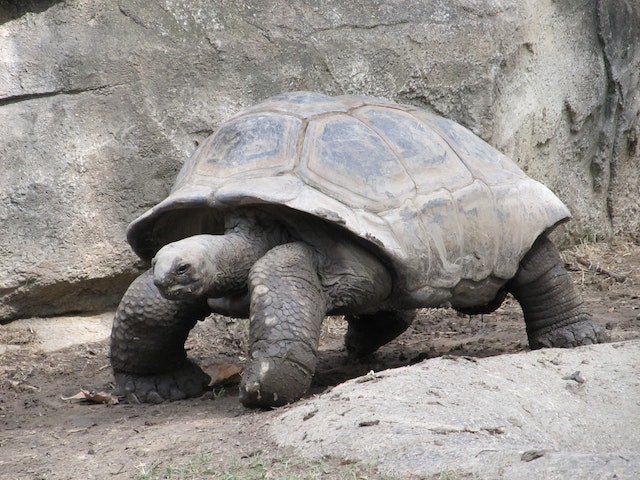
Can a tortoise live without its shell? No. Tortoises and turtles are not just inside their shells. They are the shells. The shells are part of their skeletons.
Tortoises and turtles actually come from the same family. In fact, tortoises are turtles. They all come from the family testudines, which are reptiles with a shell that is attached to their ribs. We separate them into turtles that live in the water and tortoises that live on the land, even though they are all air breathing reptiles. Turtles and tortoises have a few other differences as well. Tortoises have a rounder, more domed shell. Turtles have a thinner, streamlined shell. Tortoise shells are harder and turtle shells are softer, with a leathery texture. Tortoises have strong legs that can carry their weight and turtles’ legs are closer to flippers. Tortoises live longer than turtles. The largest tortoise is the giant tortoise and it can live to 120 years. The largest turtle is the leatherback and it can live to about 50 years.
So, what about their shells? Tortoises’ and turtles’ shells are both made of bone. Tortoise shells are made of bone and they have an outer layer of scutes. These are horny plates made of keratin and you can also see them on crocodiles and birds’ feet. They protect the bone of the shell from scratches and impacts, giving it a buffer layer. They also make the color and shape that we know as “tortoise shell”. The top part of the shell is called the carapace and is the big domed section. The bottom part is called the plastron and goes underneath the tortoise, between its legs. The top and bottom parts are joined at the side by bridges. Turtles’ shells are also made of bone, but they don’t have the layer of scutes. The bone in their shells is also less ossified, so it stays softer.
It looks like the tortoises are living inside their shells, but the shells are a part of their skeleton. Their ribs and their spines are fused to the carapace. If you look at the skeleton of a tortoise, the spine runs down the center and the ribs fan out, connecting to the shell on each side. The legs, neck, and tail connect to the spine and are free to move, but the spine and the ribs cannot move. Then, the whole shell is covered in skin. The cutes grow on the outside of the skin to protect everything. Turtles don’t have the scutes, so the top of their shells are covered in skin, which is what gives them the leathery texture. Because both tortoises and turtles are covered in a layer of skin, it means they can feel things touching their shells. Their skin has nerves, just like ours does, so they can feel pressure on the shells.
Most exoskeletons don’t grow and the animals have to shed them and grow a new one each time they get too small. Tortoise and turtle shells are made of bone and they grow with the animal. They are born with their shells and their shells get bigger as they do.
Turtles and tortoises have very strong neck muscles and a very long neck, which is why they are able to move their heads so far and pull their heads back into their shells. They need this because they cannot move their spines and their plastron extends out underneath their heads. If they had shorter necks, they wouldn’t be able to eat.
Tortoises and turtles have strong shells and they look pretty secure, but there are still animals that prey on them. Turtles can be eaten by sharks and other large fish. A Great White Shark and a Tiger Shark can easily bite through a turtle shell. Smaller sharks can’t bite through the shell, so they attack the bits of the turtle that stick out. Tortoises are preyed upon by animals like coyotes and raccoons. They can’t crack the shells, but they can get to the tortoises even when they are hiding. Some large birds of prey, like the Golden Eagle, pick up the tortoises and drop them from a great height, coming down to eat them after their shells have broken. Also, chimpanzees eat tortoises. They pick them up and bang them against tree trunks until their shells break.
So, a tortoise and a turtle cannot live without their shell because their shell is a part of their skeleton and not something they live in. Trying to remove a tortoise from a shell would be the same as pulling you out of your bones. And this is what I learned today.
Photo by Pixabay: https://www.pexels.com/photo/black-tortoise-standing-162307/
Sources
https://www.nashvillezoo.org/our-blog/posts/turtles-vs-tortoises
https://en.wikipedia.org/wiki/Turtle_shell
https://en.wikipedia.org/wiki/Turtle
https://en.wikipedia.org/wiki/Tortoise
https://animals.howstuffworks.com/reptiles/turtle-shell.htm
